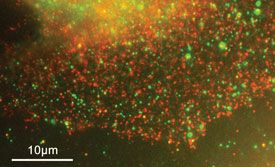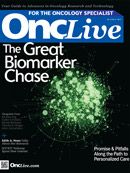Publication
Article
Oncology Live®
New Clinical Trial Designs Needed for Marker-Based Studies
Author(s):
The oncology community is quite conversant with the clinical utility of prognostic tumor markers.

Image of mammary epithelial cells, with HER3 in green and HER2/ neu in red.
The oncology community is quite conversant with the clinical utility of prognostic tumor markers. Baseline and serial changes in the level of serum markers in prostate, ovarian, and colon cancers, and morphologic features present within biopsy specimens such as tumor grade provide relevant insights into the anticipated natural history of an individual patient’s cancer.
Unfortunately, and of critical importance, knowledge of such prognostic results does not indicate that the clinician can actually utilize the information to favorably impact that outcome.
The idea that specific test results relevant to the malignant cells present in an individual cancer patient may be used to assist in defining appropriate treatment is not a novel concept, having been employed routinely for several decades in administering hormonally-based therapy in patients with breast cancer. Now, advances in our understanding of the unique drivers of tumor progression have rather dramatically accelerated the utility of predictive tumor markers in oncology practice.
Molecular markers that have become a routine component of standard of care include HER2 amplification (defining breast cancer patients to be treated with trastuzumab), the presence of a mutated epidermal growth factor receptor (EGFR) gene (defining the non-small cell lung cancer [NSCLC] population likely to benefit a tyrosine kinase inhibitor), and the presence of an abnormal KRAS gene (defining a metastatic colon cancer subgroup unresponsive to anti-EGFR antibody therapy).
Recently added to this rapidly growing list are highly specific molecular abnormalities that quite clearly define distinct subsets of patients who have an impressively high probability of achieving a meaningful biological and clinical response to unique antineoplastic agents whose activity has been predicted by the presence of the marker. Examples include BRAF mutations in malignant melanoma (Clin Cancer Res 2011;17[7]:1658-1663), and ALK rearrangements in NSCLC (Clin Cancer Res 2011;17[8]:2081-2086).
A critical component of the discussion involving the future role of molecular tumor markers involves the level of evidence required to accept a specific biological marker as being valid for routine clinical use. From the perspective of optimal scientific proof, the results of phase III trials should be required to definitively document the utility of marker-defined delivery of a novel antineoplastic agent, but it is difficult—if not impossible—to imagine such studies being conducted if the specific population in question comprises a well-defined but objectively small subset of a relatively uncommon malignancy.

Maurie Markman, MD
Editor-in-Chief of OncLive
Senior vice president for Clinical Affairs and National Director for Medical Oncology Cancer Treatment Centers of America, Eastern Regional Medical Center
For example, the 5% of patients with metastatic NSCLC (the approximate incidence of ALK rearrangements) continues to represent a potentially sizable number of individuals worldwide who might be eligible for a phase III randomized trial. However, a similar or slightly higher percentage of patients with epithelial ovarian cancer (the approximate incidence of germline BRCA1 and BRCA2 abnormalities in this malignancy) would represent a very limited sample size to quickly complete a phase III trial with an overall survival endpoint.
Further, and of great concern, pharmaceutical and biotechnology companies recognizing the difficulty of documenting the superiority of a novel agent in a small molecular marker-defined patient subgroup might simply abandon efforts to examine the utility of a novel drug in this setting, despite a strong preclinical rationale and solid clinical (but nonrandomized trial) data supporting the relevance of the agent.
Therefore, it is critical that the FDA and regulatory agencies in other countries develop alternative approaches to confirm clinical benefit.
Finally, it is increasingly evident that many advanced cancers are becoming chronic disease processes where the malignancy can be controlled, perhaps for many years, but where ultimate cure is unlikely. Under this scenario, it is likely that long-term treatment will be required and that patients with advanced and metastatic cancers may be successfully managed over a protracted period of time following progression on several lines of antineoplastic regimens.
This concept of cancer care as a chronic illness has a number of important implications, including the issue of cumulative and long-term toxicity of therapy. The difficulty of demonstrating that a specific therapeutic program administered today will impact an overall survival endpoint also has a bearing on drug development.
Patients may ultimately receive multiples lines of reasonable treatment following completion of a particular management program, each of which may favorably—even substantially—influence an individual patient’s survival completely independent of the impact of the treatment the patient is receiving today.
From the perspective of randomized trials being conducted for drug registration purposes, this evolution strongly suggests that alternative study endpoints (eg, progression-free survival, time to worsening of clinically relevant symptoms) would be far more objectively valid tests of the utility of a specific management strategy compared with its impact on overall survival, which nevertheless remains an important goal.









